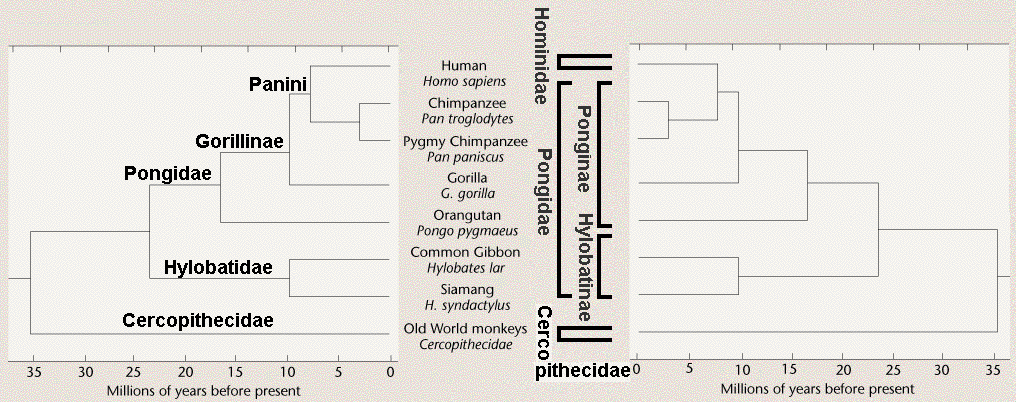
Cladistic versus Traditional Classification of Anthropoid primates

Cladistic versus Traditional Classification of Anthropoid primates
Traditional classification
[right] is based on perceptions of groups
of similar organisms, as indicated by the
brackets at right. The anthropoid ("man-like") Apes are distinguished from Old
World Monkeys by the absence of a tail. Among Apes, there is a
strong perception that Humans are very distinct and (or)
"structurally advanced," and therefore belong in a separate
group (family Hominidae) apart from the Great
Apes (Chimps, Gorillas, & Orangutans) (subfamily Ponginae).
Among the apes, tailless Gibbons and Siamangs are perceived as "Lesser Apes" that are more
"monkey-like," and are
therefore placed in a separate family Hylobatidae,
alongside the Greater Ape family (Pongidae). By "promoting"
humans to a distinct family, this arrangement implies that
chimps are more closely related to gorillas than to humans, and
that Lesser and Greater apes are more closely related to each
other than the latter is to humans.
Phylogenetic
classification [left] assigns names to monophyletic lineages within
the evolutionary tree. Among the Anthropoid ("man-like") Apes, gibbons and
the Great Apes (including Homo) are recognized as
separate evolutionary lineages, and are placed in separate
families (Hylobatidae & Pongidae,
respectively). Within the latter, Homo, Pan,
& Gorilla are a closely related group recognizable
as a subfamily, Gorillinae. Given the recent
recognition that Homo and Pan are each others
closest living relatives, they can be recognized as a tribe, Panini.
(The name Homini is already used, and thus 'unavailable'
according to the rules). The GenBank classification
used for retrieval of DNA sequences uses a phylogenetic
taxonomy that recognizes all apes as the superfamily Hominoidea, Great Apes as
Hominidae, Gorillas,
Chimps, and Humans as three genera in the subfamily Homininae, and orangutans
as Ponginae.